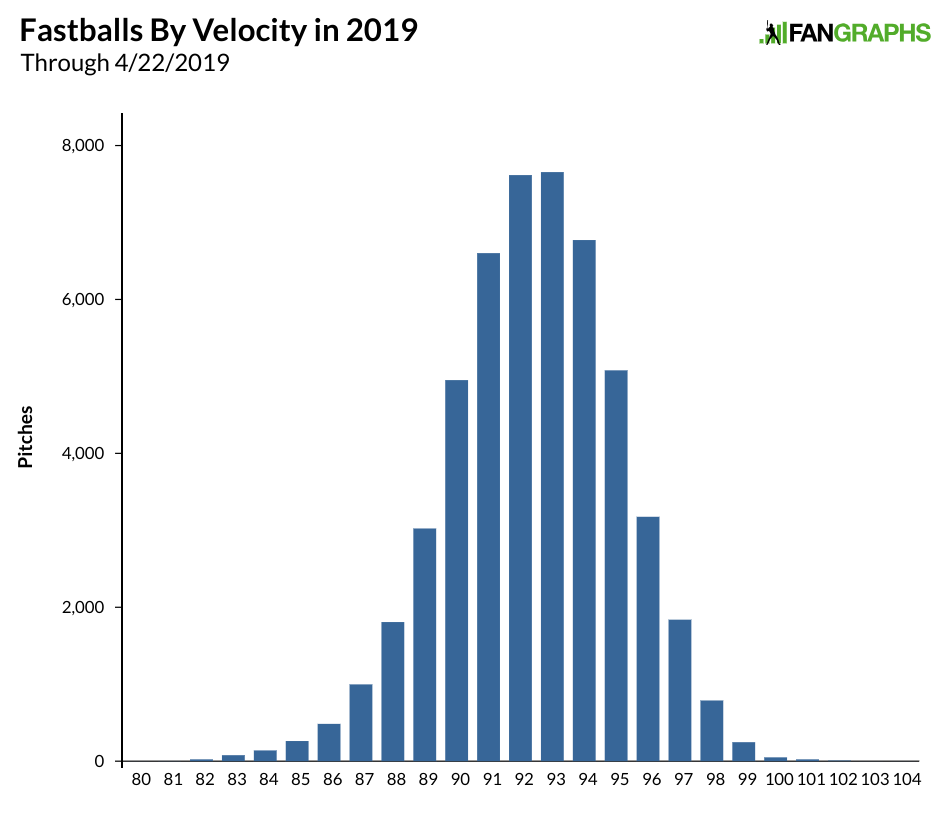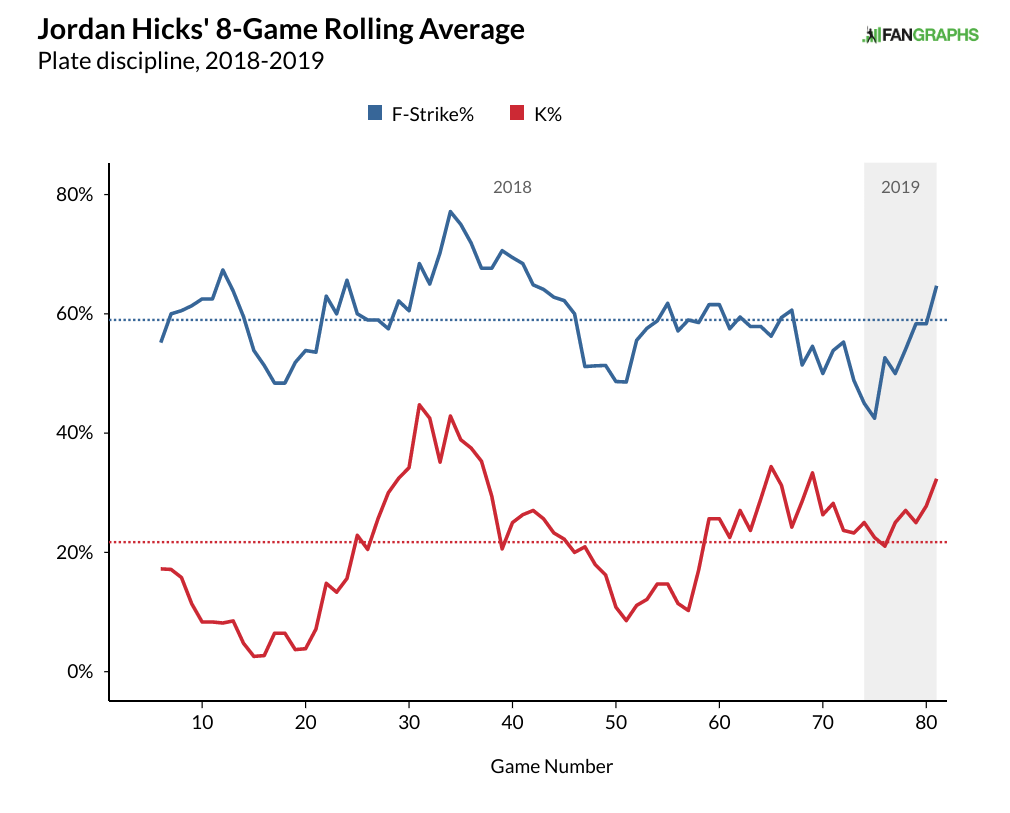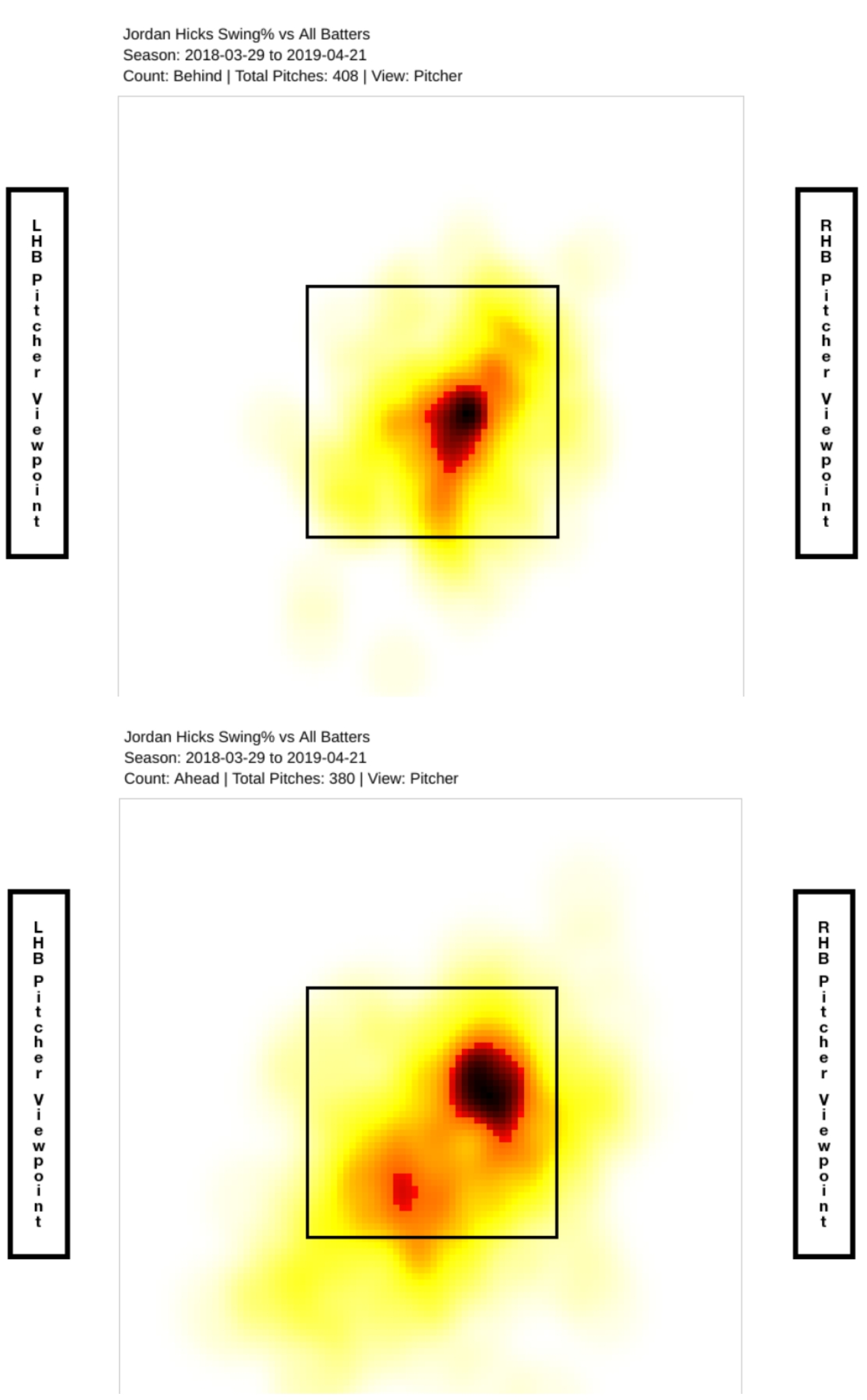The Fastest Freeze in History
All major league pitchers throw pretty hard, and on average, fastballs are hitting close to 93 miles per hour these days. Pitchers throwing 95 seems common-place, and we regularly see pitches in the upper-90s. Pitchers throwing the ball really hard seems routine, but that should make us appreciate pitchers throwing the hardest even more. As pitch velocities get higher and higher, there are still upper limits, and the players who tend to reach those upper limits seem to find themselves alone. Right now, Jordan Hicks is alone.
The graph below represents all the fastballs thrown, except those by J.R. Murphy, this season.

It might be difficult to see the bars at 102 mph and above, so here’s a chart showing those pitches.
| Player | Date | MPH |
|---|---|---|
| Jordan Hicks | 4/21 | 104.2 |
| Jordan Hicks | 4/21 | 103.7 |
| Jordan Hicks | 4/21 | 103 |
| Jordan Hicks | 4/21 | 102.8 |
| Jordan Hicks | 4/21 | 102.4 |
| Jordan Hicks | 4/17 | 102.3 |
| Jordan Hicks | 4/17 | 102.3 |
| Jordan Hicks | 4/21 | 102.1 |
| Jordan Hicks | 4/7 | 102.1 |
| Jordan Hicks | 4/17 | 102.1 |
| Jordan Hicks | 4/17 | 102 |
And to further clarify matters, here’s the average fastball velocity for pitchers with at least 10 fastballs this season.
| Player | Fastballs | Avg Fastball Velocity |
|---|---|---|
| Jordan Hicks | 71 | 100.5 MPH |
| Jose Alvarado | 147 | 98.3 MPH |
| Tayron Guerrero | 127 | 98.3 MPH |
| Ryan Helsley | 28 | 98.2 MPH |
| Felipe Vazquez | 129 | 98.1 MPH |
| Diego Castillo | 76 | 98.0 MPH |
| Ryne Stanek | 109 | 97.7 MPH |
| Trevor Rosenthal | 90 | 97.7 MPH |
| Lou Trivino | 64 | 97.6 MPH |
| Noah Syndergaard | 292 | 97.6 MPH |
| Robert Stock | 69 | 97.6 MPH |
| Aroldis Chapman | 106 | 97.5 MPH |
The difference between first-place Hicks and second-place Alvarado is same the distance between Alvarado and 41st-place Luis Garcia. Hicks is ahead of Garcia by nearly a full standard deviation when looking at all the fastballs thrown in the first graph above. The disparities are huge; that 104 mph fastball is more than four standard deviations away from the median. It’s hard to put that into context, but if we considered home run distances for all homers last season, an equivalent homer would travel 504 feet, 15 feet past Franchy Cordero’s 489 foot bomb that topped the charts last season. Since Statcast began tracking homers, only two have even gone 500 feet (Giancarlo Stanton and Trevor Story) and both of those were in the thin air of Colorado.
A 104 mph fastball is special. There have only been 75 in the last dozen years thrown by four pitchers (Hicks, Chapman, Mauricio Cabrera, and Neftali Feliz), but that 104 mph pitch thrown by Hicks represents something of a rarity even among this subset. Before we go any further, here’s that 104 mph pitch.
What makes this pitch unique is that Lagares was caught looking. It’s slightly more unusual in that the pitch ended the game with the tying run at the plate. As to the first part, the table below shows the 75 pitches of at least 104 mph since 2008 and the outcomes.
| 104+ MPH Pitches | |
|---|---|
| Pitches | 75 |
| Pitches in Zone | 27 |
| HBP | 1 |
| Swings | 35 |
| BIP | 6 |
| Fouls | 22 |
| Whiffs | 7 |
| Balls | 33 |
| Strikes Looking | 6 |
Pitchers, mainly Chapman and Hicks, have shown the ability to throw the ball extremely hard, but only a third of the pitches above even landed in the strike zone. Many more look like this Hicks pitch to Odubel Herrera last year.
When the pitch has been in the strike zone, it has induced a swing about two-thirds of the time. Only six times has a pitcher thrown a pitch at least 104 mph in the strike zone while the batter watched it go by for a strike. Of those six pitches, three were on the first pitch of the at-bat, so we really couldn’t conclude that the batter was frozen. Of the three called third strikes, this one was the slowest at 104.0 mph, and featured a difficult lefty on lefty matchup.
The Hicks pitch to Lagares is not the fastest called strike for a strikeout in history. Aroldis Chapman owns that one.
That pitch, which struck out Khris Davis with the tying run at the plate, was two-tenths faster than Hicks’ backwards K of Lagares. Chapman also has six pitches between 103 and 104 mph that struck out a player looking. The only pitchers with multiple third strikes looking at 102 mph above are Chapman, Hicks, and Henry Rodriguez. Hicks’ strikeout of Lagares is very likely the second-fastest strikeout looking in baseball history.
As for Hicks, he is thus far showing that his 2018, when he went straight from High-A to the majors, was more of a developmental season than a representation of his ability. He began 2018 with great velocity but poor command and couldn’t strike batters out. Thanks to improved command of his fastball, he was able to get ahead and use his slider to get strikeouts, and for the middle three months of the season, he was one of the better relievers in baseball before wearing down as the season ended. No matter how much the 100 mph fastball feels like it should be a strikeout pitch, the pitch is a sinker, so he needs to get ahead to use the slider and punch batters out. Looking at Hicks’ rolling first strike percentage, as well as his strikeout percentage, tells a pretty uniform tale.

Hicks has a really big slider and that big fastball, but hitters don’t swing out of the zone unless they feel they have to. Below is a heat map of Hicks’ swings against when he is behind in the count (top) compared to when he is ahead (bottom).

There are very few swings out of the zone when Hicks is behind in the count, but hitters expand the zone when Hicks gets ahead. Hicks hasn’t yet proven he can control the zone, so hitters wait to see it before they are willing to swing. So far this season, Hicks is getting those first-pitch strikes, and striking out one-third of hitters so far. The slider looks a lot like it did last season, though Joe Schwarz of The Athletic noted that Hicks moved his foot from the first base side of the rubber to the third base side, which likely makes his slider look more appealing as it darts across the plate and out of the zone. While he’s thrown fewer than 50 sliders on the season, his chase rate on the pitch is up to 41%, and his whiff rate on swings is up to 82%. Both are close to double-digit percentage point improvements over a year ago. At 22 years old Hicks is still a work in progress, but the flashes he showed last year have shown up for St. Louis so far this season as he has stabilized the backend of the Cardinals bullpen.
Craig Edwards can be found on twitter @craigjedwards.

Who is the one 104+ hit by pitch? Ouch.
Per Baseball Savant, it was AJ Pollock, 7/4/18, on a 104.3 heater from Hicks. Got him in the elbow too.
https://baseballsavant.mlb.com/sporty-videos?playId=073418ff-cf36-45d8-9e69-7a70aa464b0b
Did he have any armor on the elbow? Seems like it would shatter into pieces otherwise.
See video. He did
Looks like he had a little flap there, and it didn’t catch him square. Just dropped his bat and trotted to first. Could have been worse.
I mean, 99 still hurts like hell (to us normals, anyways).
Yeah, I have a feeling me getting hit by a 99 vs. me getting hit by a 104 would result in identical fetal positions.
In the second video above, looks like Francisco Pena took that one off of his elbow…
Literally my first thought when I looked at the table of data